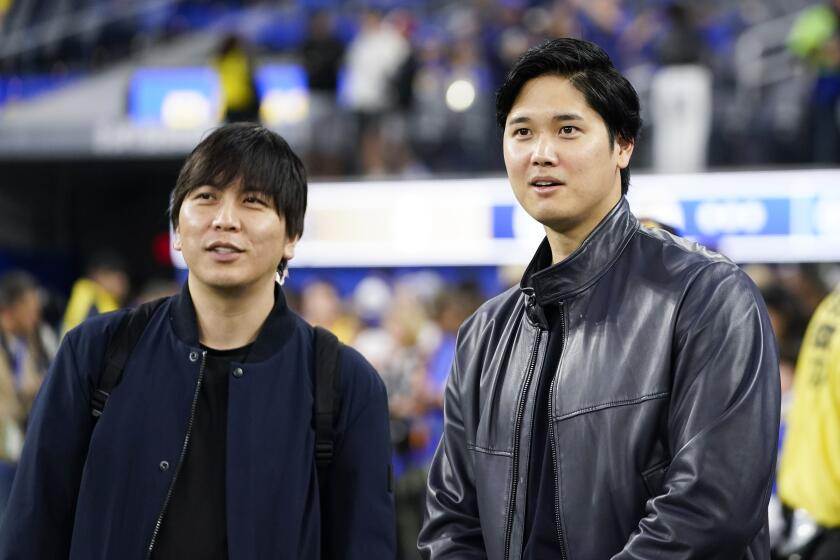The Daze of Bonuses for Babies : Baseball: In an era before the amateur draft, young prospects were available to the highest bidder.
Baseball’s first bonus babies went from hopefuls to has-beens long before Todd Van Poppel joined the Oakland Athletics’ organization last week for $1.2 million, including a $600,000 signing incentive.
The staggering numbers earned by an 18-year-old pitcher a month out of high school simply served as a reminder.
Consider Dick Wakefield, an outfielder whose biggest fault probably was that he realized how easily the game came to him.
Or Paul Pettit, the Narbonne High player who in 1950 became the first $100,000 bonus baby.
Or Rick Reichardt, who set a standard when the Angels signed him for a reported $200,000 in 1964.
Or Pat Jordan, who spent one part of his last day in high school going through graduation ceremonies, and the other sitting in his Fairfield, Conn., living room as scouts from all 18 pro teams paraded through with contracts.
These were baseball’s true bonus babies, from an era before the draft when anyone who had completed 12th grade was fair game to any team.
In 1965, the first year of the draft, Rick Monday received $104,000 from the Kansas City Athletics as the No. 1 pick, but the draft process of choosing players and negotiating with only one team changed everything. A year earlier, Reichardt received far more.
By all accounts, what made one player a bonus baby and another merely a well-paid prospect is subjective. The guy who received $150,000 was a potential star, but his teammate at $95,000 wasn’t? Van Poppel pulls in a million, but the guy who was selected fifth or sixth will merely get a nice bonus?
Clearly, things were different in pre-draft days, and it started with with Wakefield.
A 6-foot-4, 210-pound outfielder at the University of Michigan in the late 1930s, he became the sport’s first major bonus baby. The bidding in 1941 started at $25,000 and ended when the hometown Tigers gave him $52,000 and a new Cadillac.
When Wakefield hit .316 as a rookie in 1943 and led the American League with 200 hits and 38 doubles, potential was becoming reality. No one was surprised, least of all Wakefield. He predicted that he would compile better statistics than Ted Williams, a challenge he personally made to Williams when both were in the Navy.
The 1943 All-Star game was the stage for the most famous Wakefield story. Manager Joe McCarthy gave him the bunt sign. The rookie swung away and doubled.
“You miss the sign, kid?” McCarthy asked later.
“Nope,” Wakefield answered with a shrug of his shoulders. “I just didn’t like the pitch. I knew I could hit him anytime I wanted.”
He followed the great rookie year by hitting .355 in the half-season before entering the service. By the time he returned to the game in 1946, Wakefield had lost his swing. When he didn’t seem bothered in the least, all the got-rich-too-quick comments came like Bob Feller fastballs.
Wakefield never hit better than .283 the rest of his career. His nine-year total with the Tigers, New York Yankees and New York Giants was .293, but he played only 65 games during those last three seasons.
“I’m probably the poorest ex-ballplayer you could find,” he said in a 1983 interview with Maury Allen. “All I got is a roof over my head and a few cats to take care of.”
He died in 1985.
Pettit--the Wizard of Whiff, as he was known in his hometown of Lomita--drew attention from the moment the Pittsburgh Pirates won a bidding war for his services on Feb. 1, 1950, the day after high school graduation. At double-A New Orleans, his first stop in the minor leagues, he would go to the movies, and the next day a picture of Pettit standing in line would be in the paper.
In his third start with the Pelicans, Pettit hurt his elbow. Later, while trying to compensate, he hurt the shoulder. The arm that once registered 89 strikeouts in 47 innings at Narbonne was never the same.
His first chance at the majors came in 1951: two games, 2 2/3 innings, one walk, 3.38 earned-run average. Called up again in 1953, he went 1-2 in 10 games with 14 strikeouts and 20 walks in 28 innings. So much had changed.
Sent back to the minors in June of ‘53, he never returned. Pettit later played first base for the old Hollywood Stars of the Pacific Coast League, but he did not get an invitation to spring training despite hitting .284 with 20 home runs and 102 RBIs. After that, he had a stint in the Mexican League before retiring in 1961.
Pettit’s association with baseball, the game he continued to love even after his disappointing career, lasted until 1968, when he managed in the minor leagues.
Jordan’s career was even shorter. He never got to the majors after the Milwaukee Braves signed him in 1959 for $40,000 and agreed to pay his college tuition during the off-season. That came during the pitcher’s hectic senior year of high school baseball.
“It was like the stock market,” Jordan recalled. “I’d strike out 12 guys on Tuesday and be up to $100,000. I’d strike out only six or eight on Friday and be down to $30,000. The pressure was so phenomenal that, literally, I couldn’t sleep. Doctors had to prescribe medication for me to get some rest.”
But, he said, those pressures didn’t cause his downfall. After going 3-3 for McCook, Neb., in the Nebraska State League, the problems started after finishing 6-12 with Davenport, Iowa, in Class D. The third year, at Class-C Eau Claire, Wis., Jordan got so paranoid about his lack of success that he changed his pitching motion.
Gone for good, in a heap of what-ifs.
“The problem was, I was too goal-oriented,” he said. “I went to the minor leagues with some very unreasonable goals, like making it to the major leagues in two years. I was very tense because of that. I pressed every start.
“With my temperament, I was never going to make it. It wasn’t the bonus that ruined me. I was going to ruin myself no matter what.”
Not that the grandiose expectations helped.
“Because you’re a bonus baby, everything was magnified,” he said. “You were supposed to be better than everyone else. I played with Phil Niekro at McCook and he got something like $750 to sign, but look where he ended up. . . . I felt foolish sometimes. That one year I went 6-12, the only thing I could point to was that I led the league in strikeouts.”
Jordan, who later became a writer for Sports Illustrated and Gentleman’s Quarterly, was a power pitcher. When he pitched well in the winter instructional league in Florida but didn’t have many strikeouts, it signaled the end of his career was near.
“I was known as the bonus baby who couldn’t pitch,” he said. “People used to laugh at me.”
A baby over the hill before his time.
More to Read
Go beyond the scoreboard
Get the latest on L.A.'s teams in the daily Sports Report newsletter.
You may occasionally receive promotional content from the Los Angeles Times.






